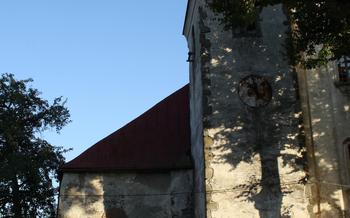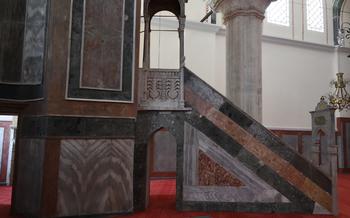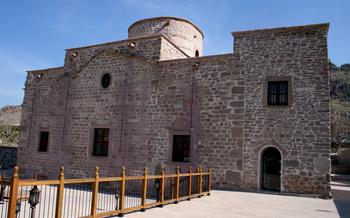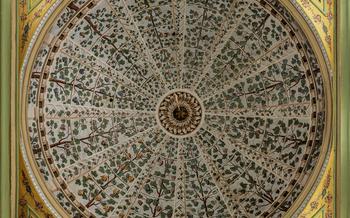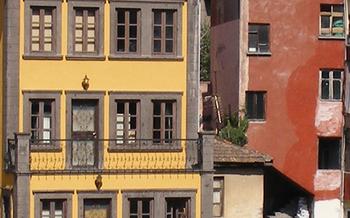
Vize Hagia Sophia Church
- History of the Vize Hagia Sophia Church
- Architectural Features
- Mosaics and Frescoes
- Significance in Byzantine Art and Architecture
- Religious Importance
- Restoration and Preservation
- Vize Hagia Sophia Museum
- Visiting the Vize Hagia Sophia Church
- Pilgrimage and Tourism
- Local Culture and Cuisine
- Exploring Vize
- Turkish Baths and Hammams
- Local Crafts and Souvenirs
- Off-the-Beaten-Path Experiences
- Insider Tip
History of the Vize Hagia Sophia Church
The Vize Hagia Sophia Church, a testament to the region's rich Byzantine heritage, stands as a magnificent monument to the enduring power of faith. Its construction dates back to the early 14th century, a time when the Byzantine Empire held sway over the area. The church's name, Hagia Sophia, is a dedication to the Holy Wisdom, a concept held in high regard by Byzantine Christians. Throughout the centuries, the church has undergone various modifications, reflecting the changing political and religious landscape of the region. While its origins lie in Byzantine Christianity, the church later fell under Ottoman rule and underwent significant changes to adapt to the new religious context. Today, it stands as a symbol of religious tolerance and coexistence, having served as a place of worship for both Orthodox Christians and Muslims.
Architectural Features
The Vize Hagia Sophia Church stands as a testament to the architectural prowess of the Byzantine Empire. Constructed using local stone, its exterior exudes a sense of solidity and grandeur. The church's facade is adorned with intricate carvings and sculptures, showcasing the artistry and craftsmanship of its builders.
Upon entering the church, visitors are greeted by a breathtaking interior. The vast central dome, supported by four massive pillars, creates a feeling of spaciousness and awe. The walls are adorned with stunning mosaics and frescoes, depicting biblical scenes and historical events. The intricate details and vibrant colors of these artworks transport visitors back in time, offering a glimpse into the rich artistic traditions of the Byzantine era.
One of the most striking features of the interior is the combination of architectural styles. The church's cruciform plan and central dome are characteristic of Byzantine architecture, while the use of ribbed vaults and pointed arches hints at Gothic influences. This unique blend of styles reflects the transitional period in which the church was built, as the Byzantine Empire began to absorb elements from Western European architecture.
Mosaics and Frescoes
The interior of the Vize Hagia Sophia Church is adorned with exquisite mosaics and frescoes that have survived the test of time. These stunning artworks hold immense historical significance, providing a glimpse into the artistic and cultural climate of the Byzantine era. The mosaics depict a variety of religious scenes, including the life of Christ, the Virgin Mary, and various saints. The vibrant colors and intricate details of the mosaics captivate visitors, transporting them back to a time when religious art flourished.
Complementing the mosaics are beautifully preserved frescoes, which add depth and dimension to the interior. These frescoes portray biblical narratives and scenes from the lives of saints, further enriching the visual storytelling within the church. The combination of mosaics and frescoes creates a harmonious and awe-inspiring space that reflects the artistic mastery of the Byzantine period.
Conservation efforts have been meticulously undertaken to preserve these precious artworks for future generations. Skilled artisans and conservators have worked tirelessly to restore and protect the mosaics and frescoes, ensuring that their beauty and significance endure. Visitors can appreciate the vibrant colors and intricate details of these artworks, which have been carefully preserved to showcase the artistic heritage of the Byzantine Empire.
Significance in Byzantine Art and Architecture
The Vize Hagia Sophia Church holds immense significance in the realm of Byzantine art and architecture. Its construction marked a pivotal moment, influencing the artistic and cultural landscape of the Byzantine Empire. The church's architectural style, intricate mosaics, and frescoes epitomize the grandeur and sophistication of Byzantine art.
The church's mosaics depict scenes from the Bible and the lives of saints, showcasing the mastery of Byzantine mosaic art. These mosaics are not only visually stunning but also serve as a testament to the theological and spiritual beliefs of the Byzantine era. The frescoes, complementing the mosaics, further enhance the church's interior with their vibrant colors and expressive figures.
The Vize Hagia Sophia Church exhibits a harmonious blend of architectural styles. Its exterior reflects the influence of Romanesque architecture, while the interior features Byzantine elements. This fusion of styles creates a unique and captivating aesthetic that distinguishes the church from other Byzantine structures.
The church's significance extends beyond its own walls, as it served as a model for other Byzantine churches in the region. Its architectural features, artistic elements, and religious symbolism were replicated in numerous other structures, contributing to the development of a distinctive Byzantine architectural style.
Examples of similar structures in the region include the Hagia Sophia in Istanbul, the Chora Church, and the Kariye Museum. These churches, inspired by the Vize Hagia Sophia, showcase the evolution and diversity of Byzantine art and architecture.
Religious Importance
The Vize Hagia Sophia Church has played a pivotal role in the Orthodox Christian community for centuries. It served as the primary place of worship for the local Greek Orthodox population during the Byzantine Empire. Throughout history, the church has witnessed numerous religious ceremonies, including baptisms, weddings, and festivals. It was also a center for learning and spirituality, where priests and monks taught religious doctrines and provided guidance to the faithful.
Over time, the church's religious significance evolved. After the Ottoman conquest, it was converted into a mosque and became known as the Eski Cami ("Old Mosque"). Despite this change, the building retained its architectural grandeur and continued to hold a special place in the hearts of the local Christian community. In 1923, following the establishment of the Turkish Republic, the building was secularized and transformed into a museum, preserving its historical and cultural legacy.
Currently, the Vize Hagia Sophia Church stands as a testament to the rich religious heritage of the region. While it is no longer an active place of worship, it remains a sacred space for many Orthodox Christians who visit it for pilgrimage and prayer. The church's enduring significance lies in its ability to bridge the past and present, connecting people to the deep spiritual traditions that have shaped this region for centuries.
Restoration and Preservation
The Vize Hagia Sophia Church, with its centuries-old history and intricate details, required a meticulous and extensive restoration process to preserve its architectural integrity and artistic legacy. The primary challenge lay in balancing the restoration with the preservation of the original fabric of the building. Skilled artisans and conservators employed traditional techniques, using materials that harmonized with the original construction.
One of the key restoration initiatives involved reinforcing the structural stability of the church. Centuries of wear and tear, coupled with seismic activity in the region, had compromised the integrity of the structure. Engineers and architects collaborated to strengthen the foundations, consolidate weakened walls, and restore the stability of the dome and arches.
In addition to structural repairs, the restoration focused on preserving and enhancing the church's intricate mosaics and frescoes. Conservators meticulously cleaned and restored these priceless artworks, using specialized techniques to remove dirt, grime, and discoloration without damaging the delicate pigments. The result was the revelation of vibrant colors and intricate details that had been obscured for centuries.
International organizations, recognizing the cultural significance of the Vize Hagia Sophia Church, played a vital role in supporting the restoration efforts. Collaborations with UNESCO and other conservation bodies provided expertise, funding, and technical assistance. Their involvement ensured that the highest standards of conservation were maintained throughout the restoration process.
The ongoing preservation efforts at the Vize Hagia Sophia Church are crucial to ensuring its longevity and continued accessibility to future generations. Regular monitoring and maintenance are carried out to address any potential issues before they escalate. By combining traditional craftsmanship with modern conservation techniques, the church's architectural and artistic heritage is safeguarded for years to come.
Vize Hagia Sophia Museum
In the aftermath of the 1912 Balkan Wars, the church underwent a profound transformation, evolving from a sacred sanctuary to a repository of history and culture. In 1965, the Turkish government recognized the immense significance of the Vize Hagia Sophia Church and declared it a museum, thereby ensuring its preservation and accessibility to the public.
Today, the Vize Hagia Sophia Museum stands as a testament to the rich tapestry of civilizations that have graced this region. Within its walls, visitors can embark on a journey through time, exploring the exquisite artifacts and exhibits that narrate the church's intriguing history. These relics, meticulously curated and displayed, provide a glimpse into the lives and beliefs of those who once worshipped within these hallowed halls.
In addition to its historical significance, the Vize Hagia Sophia Museum also serves as a vibrant cultural hub, hosting educational programs, workshops, and exhibitions that celebrate the region's diverse heritage. These events provide a platform for dialogue, learning, and appreciation of the unique traditions and customs that have shaped this corner of Turkey.
To further enhance the visitor experience, the museum has implemented accessibility features to accommodate individuals with disabilities. Wheelchair ramps, tactile exhibits, and audio guides in multiple languages ensure that everyone can fully engage with the museum's offerings. This commitment to inclusivity reflects the museum's dedication to fostering a welcoming and enriching environment for all visitors.
Visiting the Vize Hagia Sophia Church
The Vize Hagia Sophia Church stands as a testament to history and spirituality, welcoming visitors from all corners of the world. Located in the heart of Vize, the church is easily accessible by various means of transportation. The best time to visit is during the spring or fall when the weather is pleasant, and the crowds are smaller.
For a deeper understanding of the church's significance, guided tours are available. These tours provide insights into the history, architecture, and religious importance of the Vize Hagia Sophia. Alternatively, visitors can opt for self-guided exploration, allowing them to wander through the church at their own pace and capture the serene atmosphere.
Photography and videography are permitted within the church, enabling visitors to document their visit and share the beauty of this architectural marvel with others. However, it is essential to be respectful and avoid using flash photography, which can damage the delicate mosaics and frescoes.
Pilgrimage and Tourism
The Vize Hagia Sophia Church holds immense significance as a pilgrimage site for Orthodox Christians worldwide. It attracts numerous pilgrims who embark on spiritual journeys to pay homage to the sacred relics and experience the church's profound religious aura. The influx of pilgrims contributes to the local economy and fosters a sense of cultural exchange and understanding.
In recent years, the church has also gained prominence as a popular tourist destination. Its historical significance, architectural grandeur, and captivating mosaics draw visitors from across the globe. The church's transformation into a museum has further enhanced its appeal, making it accessible to a broader audience interested in exploring its rich heritage.
To promote sustainable tourism practices and preserve the church's sanctity, local authorities have implemented various measures. These include responsible waste management, guided tours that minimize environmental impact, and educational programs that raise awareness about the church's historical and cultural significance.
Through collaboration with local communities, tourism initiatives aim to showcase the region's traditions, customs, and culinary delights. Visitors can immerse themselves in the local culture by savoring regional delicacies, participating in traditional festivals, and engaging with the friendly locals.
Local Culture and Cuisine
Embark on a culinary adventure in Vize, where the local cuisine tantalizes your taste buds with an array of traditional dishes and flavors. Indulge in the region's succulent lamb dishes, such as the aromatic kuzu güveç (lamb casserole) or the mouthwatering kuzu şiş (lamb skewers). For a vegetarian delight, savor the delectable yaprak sarma (stuffed vine leaves) or the refreshing cacık (cucumber-yogurt soup). As you explore the streets, discover charming restaurants and cafes nestled near the Vize Hagia Sophia Church, inviting you to immerse yourself in the local culinary scene.
Remember to observe local customs and etiquette while dining. Show respect by removing your shoes when entering a mosque or someone's home. When invited to share a meal, it is customary to accept graciously and express gratitude to your host. Embrace the opportunity for cultural immersion by engaging with the locals, learning a few Turkish phrases, and immersing yourself in the vibrant atmosphere of Vize.
Exploring Vize
Beyond the Vize Hagia Sophia Church, the town of Vize offers a wealth of historical and cultural attractions, as well as natural wonders. Explore the ancient Vize Fortress, a testament to the town's rich history. Immerse yourself in the tranquility of the Vize Olive Oil Museum, showcasing the region's renowned olive production. Take a stroll through the charming streets, admiring the traditional Ottoman-era houses and vibrant local markets.
For nature enthusiasts, Vize is a gateway to breathtaking landscapes. Discover the cascading waterfalls of Kıyıköy, a haven for tranquility and natural beauty. Embark on a scenic hike through the Vize Forest, home to diverse flora and fauna. Cycle along the scenic trails, immersing yourself in the tranquility of the countryside.
Venture beyond Vize to explore nearby towns and villages, each with its unique charm. Visit the historic town of Ipsala, renowned for its traditional houses and vibrant weekly market. Explore the picturesque village of Demirköy, nestled amidst lush forests and cascading waterfalls. Discover the ancient ruins of Bizye, offering a glimpse into the region's rich past.
Throughout the year, Vize comes alive with local festivals and events that celebrate the town's heritage and traditions. Experience the vibrant colors and infectious rhythms of the annual Vize Olive Festival, showcasing the region's culinary delights and cultural performances. Immerse yourself in the lively atmosphere of the Vize Grape Harvest Festival, a celebration of the region's viticulture and winemaking traditions.
Turkish Baths and Hammams
In the vicinity of the Vize Hagia Sophia Church, you'll find a rich tapestry of Turkish baths and hammams, steeped in centuries of tradition. These establishments, known for their therapeutic and cleansing properties, offer a unique cultural experience that's not to be missed.
Immerse yourself in the soothing steam and heat of these bathhouses, where you can indulge in a traditional bathing ritual that includes a full-body scrub, massage, and relaxation period. The skilled attendants, using centuries-old techniques, will guide you through an experience that promises to leave you feeling refreshed, rejuvenated, and utterly pampered.
Beyond their physical benefits, Turkish baths and hammams hold significant cultural and social importance. They serve as communal spaces where people from all walks of life come together to socialize, relax, and connect. The intricate architecture, often adorned with intricate tiles and mosaics, adds to the enchanting ambiance of these establishments.
Visiting a Turkish bath or hammam near the Vize Hagia Sophia Church is an opportunity to delve into a cherished local tradition and experience firsthand the essence of Turkish culture. Embrace this unique wellness experience and emerge feeling revitalized and invigorated.
Local Crafts and Souvenirs
Vize, Turkey, is known for its rich cultural heritage, which is reflected in the local crafts and souvenirs available to visitors. From intricate handmade rugs and textiles to unique pottery and jewelry, there is a wide array of treasures to discover.
Strolling through the charming streets of Vize, you'll find local artisans showcasing their skills and offering their creations. Visit the vibrant markets or explore the quaint shops to unearth authentic souvenirs that capture the essence of the region.
When searching for genuine handicrafts, look for items made using traditional techniques and materials. Whether it's a colorful carpet adorned with intricate motifs or delicate silver jewelry inspired by ancient designs, each piece tells a story of the region's artistic legacy.
Haggling and bargaining are common practices in local markets, allowing you to engage with the artisans and negotiate a fair price. It's an opportunity to connect with the locals and support their livelihoods while taking home a unique memento of your travels.
By purchasing local crafts and souvenirs, you not only acquire beautiful objects but also contribute to preserving the cultural heritage of Vize. Your support helps sustain traditional artisanship and ensures that these skills continue to be passed down through generations.
Off-the-Beaten-Path Experiences
Beyond the renowned Vize Hagia Sophia Church, Vize offers a treasure trove of hidden gems and lesser-known attractions waiting to be discovered. For adventurous travelers seeking unique experiences, here are some off-the-beaten-path recommendations:
-
Explore the Ancient City of Vize: Uncover the remnants of Vize's rich past by visiting the ruins of the ancient city, including the impressive city walls, gates, and towers. Immerse yourself in the history and imagine the bustling life that once thrived within these walls.
-
Hike to the Vize Waterfall: Immerse yourself in nature's tranquility with a hike to the picturesque Vize Waterfall. Surrounded by lush greenery, the cascading waters offer a refreshing respite from the city's hustle and bustle. Pack a picnic lunch and enjoy a serene moment amidst the natural beauty.
-
Visit the Vize Museum: Delve deeper into the region's history and culture at the Vize Museum. This hidden gem houses a collection of artifacts, photographs, and documents that provide insights into Vize's past, from ancient times to the present day.
-
Participate in a Traditional Turkish Cooking Class: Immerse yourself in the local cuisine by taking a hands-on cooking class. Learn the art of preparing traditional Turkish dishes using fresh, local ingredients. Enjoy the fruits of your labor with a delicious meal shared with your fellow classmates.
-
Volunteer with Local Organizations: Give back to the community and gain unique insights into local life by volunteering with organizations that work on various projects, such as environmental conservation, education, or social welfare. This is a rewarding way to connect with the locals and make a positive impact.
Insider Tip
Beyond the historical and architectural significance of the Vize Hagia Sophia Church, there are hidden gems and unique experiences waiting to be discovered. Here are some insider tips to enhance your visit:
- Secret Spots for Photography:
Venture off the beaten path to find hidden spots that offer stunning perspectives of the church. Explore the surrounding hills for panoramic views or capture unique angles from the nearby riverbank.
- Personalized Experiences with Local Guides:
Connect with local guides who can provide personalized tours tailored to your interests. They can share insights into the church's history, hidden stories, and local traditions, creating a truly immersive experience.
- Traditional Festivals and Events:
Time your visit to coincide with local festivals and events that showcase the vibrant culture of Vize. Participate in traditional dances, savor local delicacies, and immerse yourself in the lively atmosphere.
- Serene and Spiritual Moments:
Visit the church early in the morning or during sunset hours when the light casts a magical glow on the building. Experience a sense of tranquility and spirituality as you admire the intricate mosaics and frescoes in the serene ambiance.

